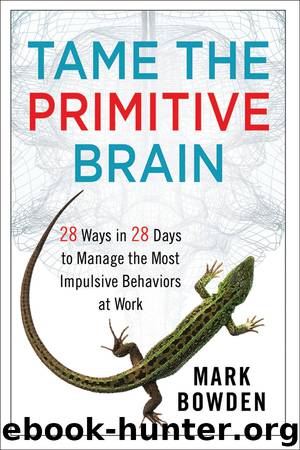Tame the Primitive Brain: 28 Ways in 28 Days to Manage the Most Impulsive Behaviors at Work by Mark Bowden

Author:Mark Bowden
Language: eng
Format: epub
Publisher: Wiley
Published: 2013-01-25T16:00:00+00:00
Emotion, Mirrors, and Empathy
Emotional contagion stems from our primitive ability to mirror the feelings of others and thus empathize with them.
Most people are confident they can interpret the emotions of others from subtle facial expressions, as well as more obvious physical behaviors (what many call body language). This process of “reading” another’s emotions is mediated by the cells in our brain—the aforementioned mirror neurons—that cause the stimulation of the muscular activities underlying these emotion-based behaviors.
For example, have you ever noticed that if you “act out” the facial expressions or physical gestures and movements associated with an emotional state (like fear, sadness, joy, etc.), you start to actually feel something of the emotion itself—and sometimes get quite overwhelmed with the feeling? Indeed, many professional actors use this “method of physical action” to access a real—or as some might refer to it, “authentic”—emotional state so that they can convincingly portray the character they are playing.
Of course, when you watch an actor’s performance on film, you know that the emotions he was “feeling” stopped when the director yelled “Cut!” Nevertheless, your understanding of the character’s mental and emotional state—which is based on your mirroring of his physical state—creates an emotion in you that you project back onto the character (or monster, or animation, for that matter) on the screen. In other words, the character’s emotions feel real to you—and they are, because they are now your emotions. You have become empathetic.
We can think of empathy as the ability to experience another person’s reality. Mirroring is the neural mechanism by which we automatically understand other people’s actions, intentions, and emotions. Based on this theory, the relatively recent discovery of mirror neurons (c. 1980) is considered by some to be an important piece of the puzzle showing how we connect with others—and, therefore, why we are social creatures. For communication to succeed, however, both the individual sending a message and the individual receiving it must recognize the significance of the signal being sent.
Mirror neurons provide a mechanism for sharing both the feeling and intention of the message—things that often aren’t encoded in the message itself. Hence, when we are bonded to our friends, we are able to pick up their meaning better than we can from people we barely know. This is why, when we find it hard to bond or link with someone, we often say we “just don’t get them.” We might find them confusing; or we may just be indifferent to them.
Download
This site does not store any files on its server. We only index and link to content provided by other sites. Please contact the content providers to delete copyright contents if any and email us, we'll remove relevant links or contents immediately.
The Compound Effect by Darren Hardy(8512)
Tools of Titans by Timothy Ferriss(7813)
Nudge - Improving Decisions about Health, Wealth, and Happiness by Thaler Sunstein(7242)
Win Bigly by Scott Adams(6827)
Deep Work by Cal Newport(6563)
Rich Dad Poor Dad by Robert T. Kiyosaki(6176)
Pioneering Portfolio Management by David F. Swensen(6079)
Principles: Life and Work by Ray Dalio(5961)
The Barefoot Investor by Scott Pape(5590)
Digital Minimalism by Cal Newport;(5389)
Grit by Angela Duckworth(5297)
The Slight Edge by Jeff Olson(5200)
Discipline Equals Freedom by Jocko Willink(5157)
The Motivation Myth by Jeff Haden(5004)
You Are a Badass at Making Money by Jen Sincero(4657)
The Four Tendencies by Gretchen Rubin(4424)
Eat That Frog! by Brian Tracy(4149)
The Confidence Code by Katty Kay(4039)
Bullshit Jobs by David Graeber(3831)
